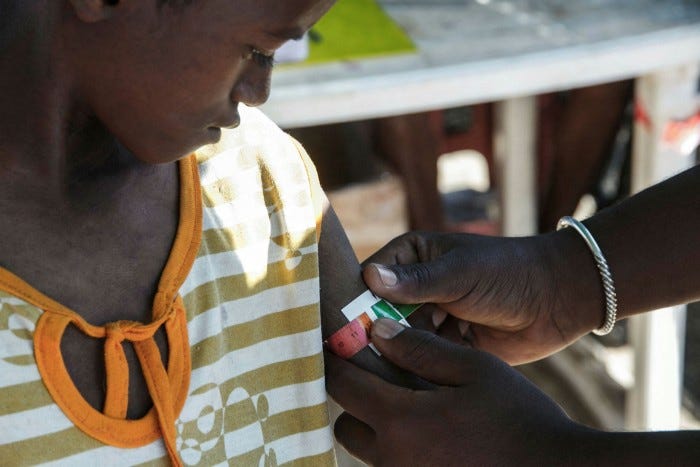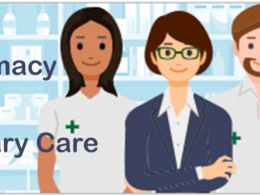Broader funding, registration and stewardship is pivotal to making the antibiotic market more sustainable
A global antibiotic access facility — financed by development agencies, philanthropic institutions and the middle-income countries themselves — could reward pharmaceutical manufacturers for making their products more widely available.
Financial Times
Ramanan Laxminarayan
APRIL 13 2022
A pharmacy in Buenos Aires. Antibiotic makers often perceive potential revenues in low- and middle-income countries as not enough to justify the cost of market entry © Marcelo Endelli/Getty
The writer is founder and director of the One Health Trust in Washington, a senior research scholar at Princeton University, and board chair at the Global Antibiotic Research & Development Partnership in Geneva
As the latest wave of Covid-19 wanes, the hidden pandemic of antibiotic-resistant infections is becoming apparent.
Recent estimates indicate that about 1.3mn deaths each year are caused by drug-resistant infections — more than the toll from any infectious disease, apart from Covid-19 and tuberculosis.
…about 1.3mn deaths each year are caused by drug-resistant infections — more than the toll from any infectious disease, apart from Covid-19 and tuberculosis.
These deaths reflect a growing resistance, and lack of access, to affordable and effective antibiotics, especially for people living in low- and middle-income countries.
These deaths reflect a growing resistance, and lack of access, to affordable and effective antibiotics, especially for people living in low- and middle-income countries.
There is now growing — if still grossly inadequate — attention being paid to preventing resistance and developing new drugs.
But the international response has largely ignored the matter of access to them, to the detriment of immediate health needs and the long-term effort to curb drug-resistant infections.
A team of Norwegian and US researchers (including me) recently showed that nearly 40 per cent of new antibiotics launched between 1999 and 2014 were registered for sale in fewer than 10 countries.
… nearly 40 per cent of new antibiotics launched between 1999 and 2014 were registered for sale in fewer than 10 countries.
That is an enormous missed opportunity for antibiotic developers and for patients in the more than 185 countries where the drugs were not made available.
Even where treatments are on sale, they are often too expensive.
Meanwhile, bottlenecks and shortages caused by limited production are increasingly plaguing health systems worldwide, including in Europe and the US.
There are many reasons why some antibiotics are not available more widely.
The most common is that companies perceive the potential revenues and market size in low- and middle-income countries as insufficient to justify the cost of market entry.
Yet the patients most in need are in those very countries.
The pipeline of new antibiotics remains limited in cases where manufacturers are not able to make a reasonable financial return to justify their investment.
Many biotech companies have faced insolvency, even when successfully developing new drugs, as happened three years ago with Achaogen.
New approaches are needed …
… to help simultaneously solve the problems of poor access in low- and middle-income countries, and the lack of financial sustainability for the antibiotics market globally.
A global antibiotic access facility financed by development agencies, philanthropic institutions and the middle-income countries themselves could reward pharmaceutical manufacturers for making their products more widely available.
Such a facility should be designed not only to provide funding, but also to help ensure the medicines are used appropriately and judiciously — otherwise known as antibiotic “stewardship”.
A global antibiotic access facility financed by development agencies, philanthropic institutions and the middle-income countries themselves could reward pharmaceutical manufacturers for making their products more widely available.

Stewardship programmes can be a disincentive for pharmaceutical companies because they lower sales by discouraging indiscriminate use.
But, if poorer countries were signed up to a mechanism that supplied needed antibiotics, more manufacturers could operate sustainably.
Such an approach works for drugs for tuberculosis, for instance.
Beneficiary countries would be required to be actively involved, including as funders, to ensure shared ownership and responsibility.
Innovation, access and stewardship have been described as the three essential legs of a balanced response to the antibiotic resistance crisis.
Innovation, access and stewardship have been described as the three essential legs of a balanced response to the antibiotic resistance crisis.
Innovating to produce new antibiotics without giving access to them is unjust — as well as likely to be unsustainable, since the companies producing them will struggle to survive.
Similarly, giving access without stewardship is wasteful, because resistance will develop quickly to drugs that are not used carefully.
And stewardship, on its own, both constrains access and discourages innovation.
Companies perceive the potential revenues and market size in low- and middle-income countries as insufficient to justify the cost of market entry. Yet the patients most in need are in those very countries
A mechanism that supports judicious access in low- and middle-income countries could incentivise all three “legs” simultaneously and save millions of lives.
This approach is being explored by Secure, …
…an antibiotic access project launched by the World Health Organization, GARDP and other partners, … that has received support from the G7 leading industrial nations and by experts from Australia, India, South Africa and the British foundation Nesta.
It need not be restricted to innovative antibiotics, either. Many other existing treatments are still not available to those in need.
A commitment to access from the global community could be linked to pledges by individual governments to simplify and align regulatory procedures — to ease registration, stewardship and appropriate use of antibiotics.
After all, inappropriate antibiotic use in any country threatens their effectiveness everywhere.
A global facility would signal to investors that the world takes the problem of antibiotic resistance seriously, and that there are strong financial returns to be made by investing in new antibiotics.
A global facility would signal to investors that the world takes the problem of antibiotic resistance seriously, and that there are strong financial returns to be made by investing in new antibiotics.
Antibiotic resistance is among the policy priorities of Germany during its presidency of the G7 this year.
Discussions in that forum and at the G20 meeting in Indonesia will provide opportunities to put judicious access at the heart of the international response to antimicrobial resistance.
Urged to tackle Aids, tuberculosis and malaria two decades ago, the world responded and saved millions of lives. A similar opportunity to avert millions of needless deaths stands before us today.
Urged to tackle Aids, tuberculosis and malaria two decades ago, the world responded and saved millions of lives. A similar opportunity to avert millions of needless deaths stands before us today.
Originally published at https://www.ft.com on April 13, 2022.
About the author
The writer is founder and director of the
One Health Trust in Washington, a senior research scholar at
Princeton University, and board chair at the
Global Antibiotic Research & Development Partnership in Geneva













